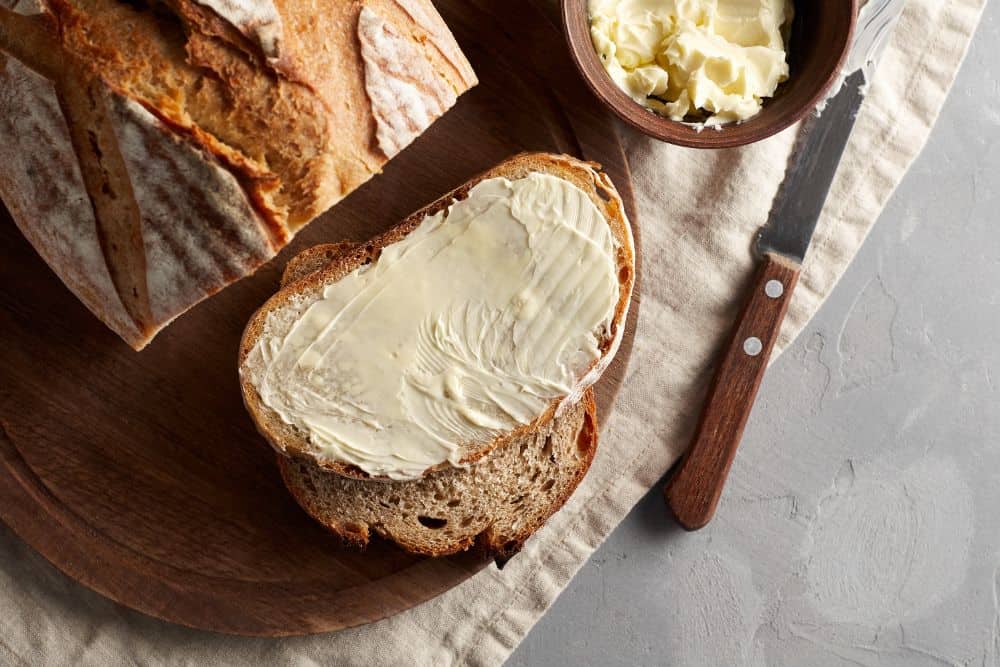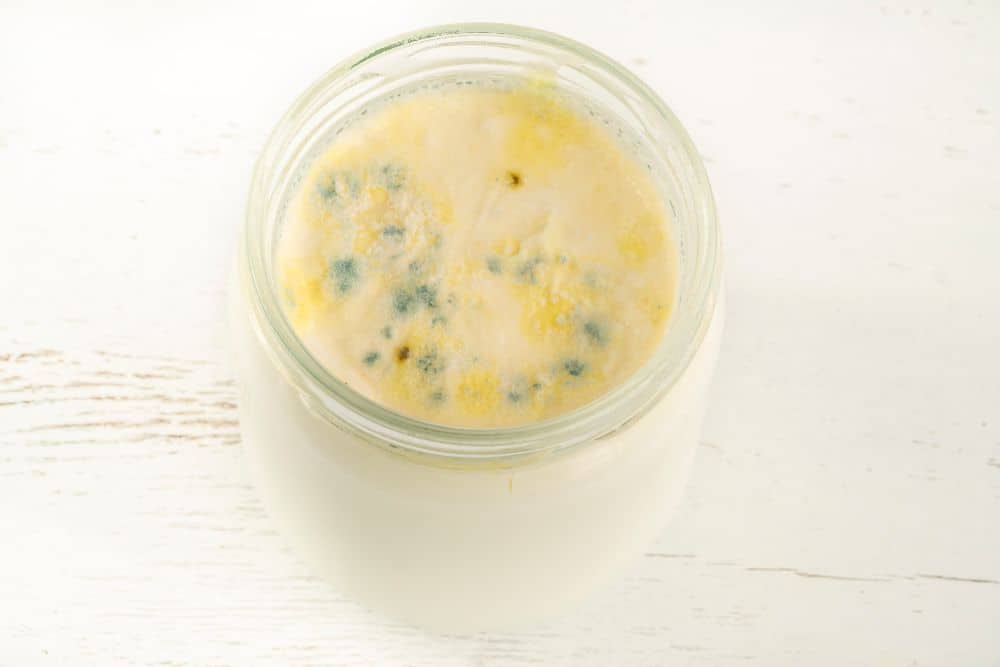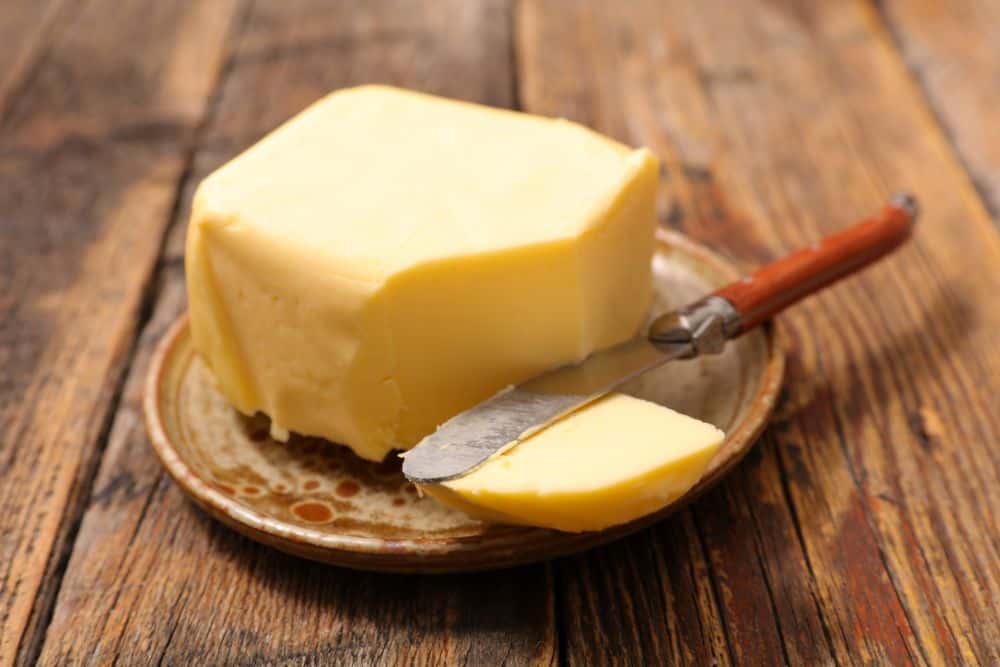Butter is a delicious addition to almost anything and is found in nearly every kitchen. It gets used so fast in most households that it seems unlikely to have enough time to go moldy! However, it is possible for butter to get moldy - and no one wants to eat spoiled butter.
Butter can grow mold when exposed to too much air, heat, or food contaminants. There are, however, ways to prevent mold growth.
Butter is a dairy product that most commonly comes from cows but can come from other animals humans use for milk, such as goats or sheep. It is a cream product, the fatty layer skimmed from the top of the milk.

Delicious Buttered Bread
To turn cream into butter is a relatively simple process called churning. To churn butter, simply mix the cream until it becomes semi-solid. Then serve this unsalted butter as is, or add salt to make salted butter.
Does butter get moldy? The typical shelf life of butter is about six months when refrigerated correctly. When butter is in the early stages of mold growth, it may be hard to tell.
If a piece of butter has advanced mold growth, it will appear hairy, making it easy to know if it isn’t good.
There are, however, a few other indicators.
Butter that has begun to go rancid and develop mold will become discolored. Butter typically has an even yellowish color. When butter develops mold spores, it will become discolored. You will likely be able to see mold starting to grow in it.
If the mold is so advanced that it covers a significant amount of the butter, it should be discarded. The mold has grown beyond what can be seen, and all of the butter is likely unusable.
Butter spoilage is disappointing, but throwing away old butter is better than becoming violently ill - so it must be tossed.

Mold Forming on Another Dairy Product - Yogurt in this case, but the mold can appear on a variety of dairy products including sour cream, slices of hard cheese, and soft cheese like brie
Butter generally has a pleasant smell, but this smell will change as the butter begins to go bad. Good butter will smell milky and sweet like most fresh dairy products, but if it has started to go bad, it will smell musty and stale.
Nauseating smell is a sign of rancidity. Very rancid butter will smell sour and foul, making it obvious it has gone bad.
The stronger the bad smell, the more likely you should throw it out. If you can easily smell the bad parts of the butter, it is likely all unusable.
If the appearance and the smell do not give it away, the taste will. As butter begins to go rancid and grow mold, it loses its delectable dairy charm and starts to taste gross.
The taste only worsens, eventually becoming so sour that it is inedible.
Even if there is no mold on the butter, it is best to throw out bad butter as it will only make whatever you add it to taste worse.
First, let's discuss talk about mold. Mold is a fungus, not a bacteria, and it tends to spread in damp environments around decaying organic matter. While butter can be affected by harmful bacteria, the high fat - low water content of butter tends to inhibit bacterial growth.
According to the USDA Journal of Agricultural Research, moldy food has numerous causes including humidity, salt content, contamination, exposure, and heat. All these can cause the butter to grow mold, though it generally occurs when two or more of these causes are present.
Mold does quite well in moist environments. High humidity is a major factor that enhances mold growth on butter.
Butter with higher salt content is less prone to mold growth versus unsalted butter or butter with a very low salt content. Salt between 2.5% and 3% works to inhibit the growth of mold on butter according to the USDA findings referenced above.
Food cross-contamination is also a major vector for mold growth. This can occur when particles from other food items get mixed in with the butter.
For example, if you spread butter on toast and then go back for more butter, you will get bread crumbs in the butter. These contaminants can cause mold growth.
Exposure to air is the most likely to cause mold growth because mold travels through the air most of the time. Mold also requires oxygen to survive and thrive. If the butter is left out on the countertop in an open container, the chances of it developing mold are much higher.
Heat is a big part of mold growth because mold grows better in higher temperatures. If butter sits out at room temperature, it is exposed to mold in the air and has a better chance of developing because of the higher temperature.
It really depends on what kind of butter you have and how you keep it to estimate how long it will take to go bad. Fortunately there are many ways to reduce your mold exposure.
For example, salted butter lasts longer than unsalted; regular butter that is properly packaged refrigerated lasts longer than butter placed on a butter dish left on a counter - especially when in a dry refrigerated environment (instead of moist); freezing butter will make it last longer than refrigerating butter.
Softened butter is obviously easier to work with than frozen or refrigerated butter. Take the butter out of the refrigerator and let it warm up for a few minutes at room temperature in a sealed butter container or covered butter dish to allow it to soften.

Properly Store Your Butter to Reduce Chances of Mold Growth
Butter stored at 50-59F will last about 221 days while butter stored at 77-95F will last for less than half that time, approximately 109 days. That means you’re safe to keep your butter if your power goes out, even for days at a time.
The best way to prevent butter from becoming moldy is to eliminate the three causes of mold growth, done by proper storage and good food sanitation habits.
First and foremost, do not use your butter knife for anything except applying butter. If you put butter on several things using one knife, thoroughly clean the knife between uses. Doing this is part of developing good food safety habits.
If you are using butter to put on bread or something else that crumbles easily, cut off the amount of butter you need before you begin spreading it to prevent contaminating the rest of the butter.
Making sure butter is not exposed to mold is vital. To do this, store butter in some kind of airtight container, keeping the butter from being exposed to any mold in the air and helping to keep it fresher. Make sure this container stays out of direct sunlight as well.
There are several options for containers. The most common ones are butter bells and butter dishes. There are no significant differences between different butter storage options, so it is simply a matter of personal preference and material.
While plastic containers tend to be cheap, glass tends to be the healthier option. It leaches less chemicals into our foods than plastic, won’t stain as easily, and retains temperature better - making it an ideal choice for storing butter.
Keeping butter in the fridge is ideal, but as long as it is in a container and out of direct heat, it should be fine on the counter. Remember that the colder butter is, the harder it is for mold to grow. So for the longest-lasting butter, put it in the fridge.
If you store it on the counter, there are a few things to remember. Since it will be at room temperature, you should take a few measures to ensure it does not get too hot. First, make sure it is out of any direct light. It should also be away from anything which produces a lot of heat.
Finally, storing it at room temperature makes it easier to use, but you should never keep too much out so it does not go bad.
For the most part, the fridge is ideal for butter, but if you have a lot, you can also freeze it. Just be aware that if you do freeze it, it will have to defrost before you use it. Freezing butter is excellent for long-term storage.
If you use margarine instead of butter, it is more susceptible to mold (though it doesn’t go bad easily, either), so keep it properly refrigerated and use it before its expiration date. Also, avoid exposing it to excess moisture as it will increase the odds of mold growing.
When butter mold, the safest course of action is to throw it out. There are steps you can take to try to salvage the butter. While it may still be safe to eat, we believe consuming products with visible mold isn't worth the risk of contracting food poisoning.
If butter smells and appears fine, only for you to eat it and find out it is bad, do not panic. Butter is often consumed in small amounts, and if you didn’t notice the mold before you ate it, it is an even smaller amount.
Be sure to dispose of the butter if you experience any symptoms.
